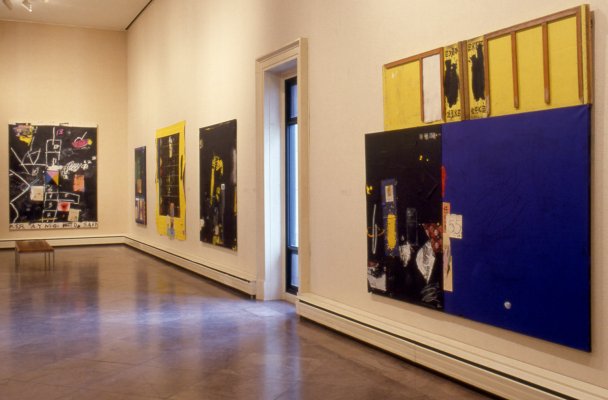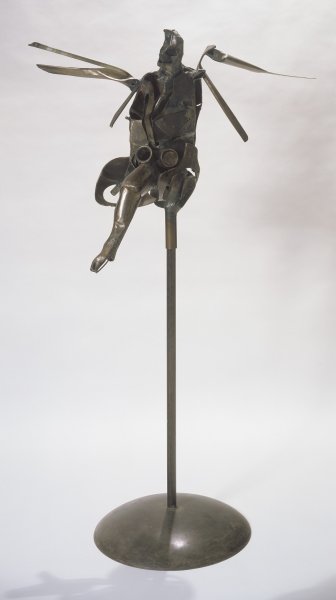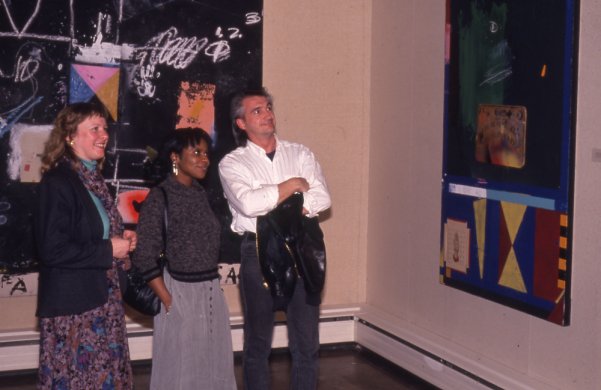The Appropriate Object
Sunday, March 5, 1989–Sunday, April 23, 1989

Installation view of The Appropriate Object. Photograph by Tom Loonan.
1905 Building
This exhibition featured the work of seven contemporary black artists, and was organized by Guest Curator Beryl Wright. The Appropriate Object highlighted works by sculptors Maren Hassinger, Richard Hunt and John Scott and painters/mixed media artists Betye Saar, Raymond Saunders, Oliver Jackson and Alvin Loving. Visitors to the exhibition were enriched by the wide range of artistic sources employed by the artists, from the modernist traditions of European-based abstraction to the rich aesthetic heritage of non-Western cultures.
The artists in this exhibition tend to work in direct construction techniques, collage and assemblage, and figurative abstraction; similarities in their works include the use of materials and imagery. Mixed-media artist Oliver Jackson creates fields, which are environmental contexts that allow body, mind, and spirit to mingle in the act of visual contemplation, such as in his Untitled (11.30.80), 1980. The carved and assembled objects that Jackson produced over the previous 10 years, such as Untitled No. 4, 1983, demonstrate the range of his technical skills and the conceptual consistency of his inventiveness.
Al Loving thinks of himself as a “material abstractionist,” and his mixed-media collages are made by layering media to create objects with a tangible material presence. Loving’s Mercer Street Series is composed of colored sheets of handmade paper which are torn or cut into a variety of shapes, and reassembled by interweaving and laminating the pieces together. Colored linen pulp is then squirted on the pieces to form an additional layer.
Betye Saar’s mixed-media work includes assemblages, altarpieces, and site installations. For pieces such as Samadhi, 1975, and Griot’s Vigil, 1986, Saar appropriates objects laced with personal and collective connotations and transforms them into resonant, spiritual apothecaries. In recent years she used handmade paper and handkerchiefs to create a two-dimensional space for abstract autobiographical pieces such as Reckless Romances, 1981.
Raymond Saunders’ paintings are visual organisms which function as repositories of memory and expose layers of experience that have permeated each other over time. An influence of 19th century landscape painting is also evident in the luminous and transcendental character of his work, as seen in China Parts, 1987, a triptych constructed of canvas and wood modules painted luminous black, blue, and yellow.
Sculptor Maren Hassinger uses twisted and splayed wire rope to create replacements for natural objects that have been lost to industrial forces. She creates faux trees, bushes, and weeds in works such as On Dangerous Ground, 1981, a site installation included in the exhibition. Hassinger also uses natural materials in the installation Blanket of Branches, 1986, creating an environment that also employs texture and scent.
Richard Hunt’s metal sculptures of the 1950s and 1960s isolate and then combine aspects of organic and manmade forms, which are structurally similar to achieve a dynamic lateral flow of associations among the elements of each piece. In Icarus, 1956, from the museum’s collection, Hunt draws on the direct metal techniques and ascendant forms of Nigerian iron ritual staffs to combine elements of bird, human, and airplane structures.
Between 1983 and 1989, John Scott created sculpture which explores “the inherent ideas and tensions that are found in the experiences we have, the historic relationship of how we’ve survived and the things that we’ve done and how those things affect visual form.” Akhanaten’s Rowboat, 1983, is loosely based on the cross-section of a slave ship, creating a transcendent image of a mythic ship. Scott’s interest in kinetic sculpture is evident in his recent work, Ibegi for Brother Garrett, 1987.
Wright, a research curator at the Newark Museum in New Jersey, wrote essays and interviewed each of the artists for the accompanying catalogue.
A lecture entitled “Re-Membering: Black Artists and the Postmodern Era” was given by Kinshasha Conwill, Executive Director of the Studio Museum in Harlem, on April 9. A concert was also given on April 16, entitled “Anthony Davis Plays Anthony Davis.”
This exhibition was organized by Guest Curator Beryl Wright.
Exhibition Sponsors
This exhibition was sponsored through the generous support of At&T. Additional funding was provided by The New York State Council on the Arts and the National Endowment for the Arts.
This exhibition was sponsored through the generous support of At&T. Additional funding was provided by The New York State Council on the Arts and the National Endowment for the Arts.

